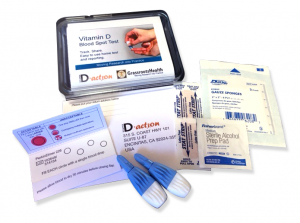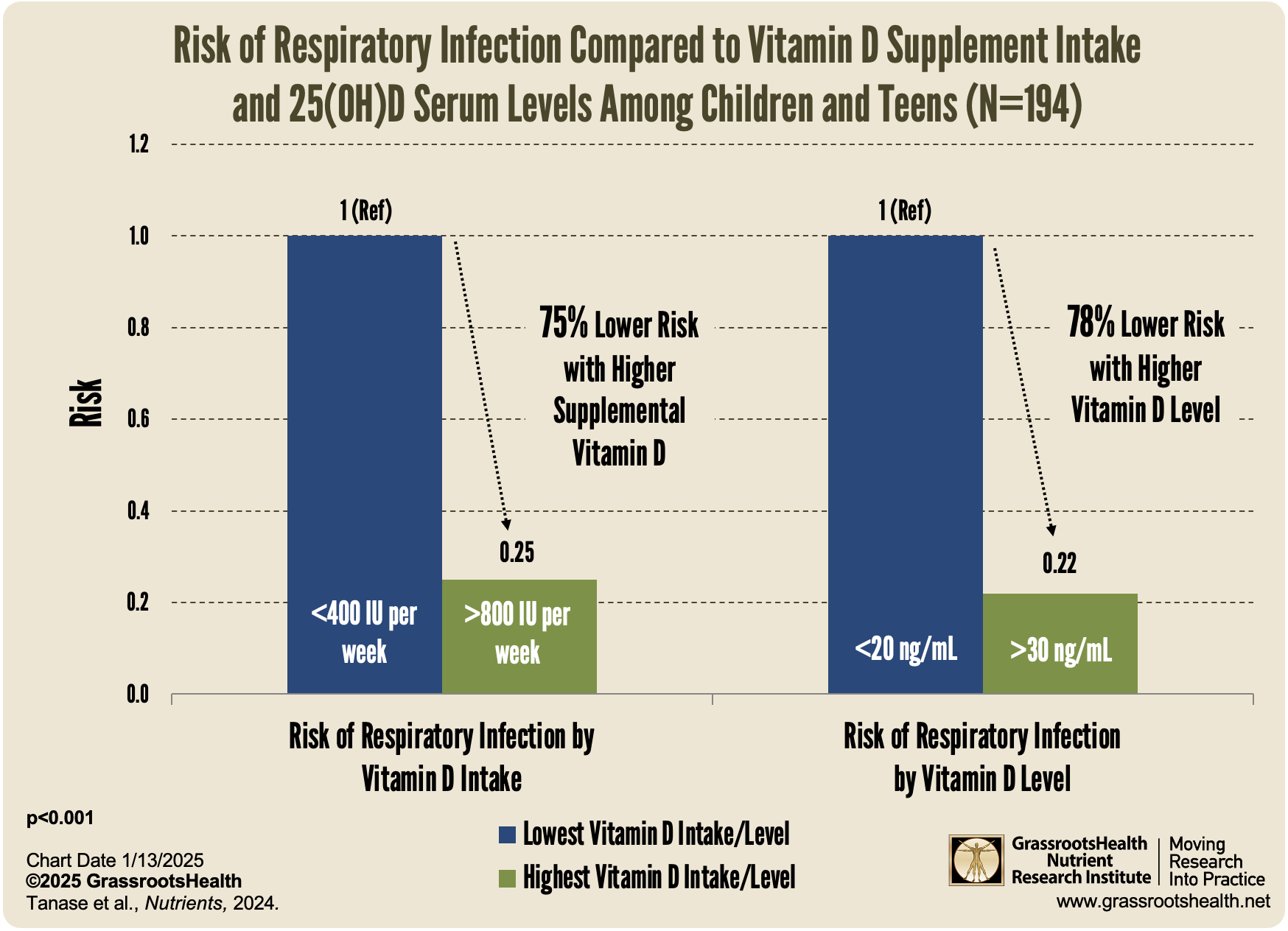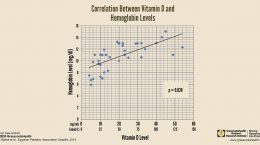Published on January 14, 2025
New study reveals a significantly lower incidence of respiratory infections among children and teens getting more vitamin D
Key Points
- A study among children and teens ages 1 through 18 years found that those getting more vitamin D had a 75% significantly reduced risk of getting a respiratory infection and those with higher vitamin D levels had a 78% significantly reduced risk of getting a respiratory infection.
- After adjusting for other potential risk factors, both vitamin D supplementation and vitamin D level were independently associated with a lower risk of respiratory infection. The study also found that the protective effect of vitamin D was highest among younger children.
- Vitamin D levels are lowest between January and March. Many vitamin D scientists and experts recommend aiming for a vitamin D level of at least 50 ng/ml (125 nmol/L) to optimize immune function and reduce infection risk… where is your level at right now?
Measure Your Vitamin D Levels Today
 Many studies have demonstrated an association between vitamin D levels and the incidence of respiratory infections, including colds and flu, making knowing and optimizing your vitamin D level a powerful tool in helping to prevent infection. Vitamin D levels are lowest during the winter months (January through March), the same time of the year when we see peak flu activity.
Many studies have demonstrated an association between vitamin D levels and the incidence of respiratory infections, including colds and flu, making knowing and optimizing your vitamin D level a powerful tool in helping to prevent infection. Vitamin D levels are lowest during the winter months (January through March), the same time of the year when we see peak flu activity.
A newly published (2024) cross-sectional study by Tanase et al. looked at the relationship between the incidence of respiratory infections among children and teens compared to vitamin D intake and levels. The study ran for 2 years and included 194 participants between the ages of 1 and 18 years. Results were grouped based on weekly vitamin D intake via supplements (<400 IU, 400–800 IU, >800 IU) and vitamin D level (<20 ng/mL, 20–30 ng/mL, >30 ng/mL).
Respiratory infections were diagnosed by a healthcare professional, and included symptoms such as cough, sore throat, runny nose, fever, and difficulty breathing. Overall, there was a 41.2% incidence of respiratory infections among all participants during the study.
How Did Vitamin D Affect the Incidence of Respiratory Infections?
The study found that those receiving the least amount of vitamin D from supplements had a significantly higher rate of respiratory infections (60%) compared to those receiving the highest amount (16.7%). Overall, those getting more vitamin D had a 75% reduced risk of getting a respiratory infection (p < 0.001).
Similarly, those with the lowest vitamin D levels experienced a significantly higher rate of respiratory infections (61.4%) compared to those with the highest vitamin D levels (16.7%). Overall, those with higher vitamin D levels had a 78% reduced risk of getting a respiratory infection (p < 0.001). Those with higher levels also had fewer recurring infections.
“As serum 25-OHD concentrations increased with higher supplementation, the incidence of having two or more respiratory infections notably decreased.”
After adjusting for other potential risk factors, both vitamin D supplementation and vitamin D level were independently associated with a lower risk of respiratory infection. The study also found that the protective effect of vitamin D was highest among younger children.
“Subgroup analyses revealed that the protective effect of vitamin D was significant across all age groups but was most pronounced in children under 6 years old. This age group is particularly vulnerable to respiratory infections due to immature immune systems and high exposure in communal settings such as daycare and preschool. The significant reduction in infection rates among younger children suggests that early intervention with vitamin D supplementation may be especially beneficial… these studies could lead to more targeted public health strategies and interventions aimed at optimizing vitamin D concentrations to prevent infections in children.”
Could Your Risk of Respiratory Infections be Reduced by Addressing Your Vitamin D Level and Other Nutrients?
Many vitamin D scientists and experts recommend aiming for a vitamin D level of at least 50 ng/ml (125 nmol/L) to optimize immune function and infection risk… where is your level at right now? Remember, other nutrients are also essential for supporting the immune system and its attack against infection.
Are You Getting Enough Vitamin D & Other Health Boosting Nutrients?
Measuring our levels of vitamin D and other important nutrients and health markers can be considered one way to check-in with our health status and guide us towards the steps to take next in improving and supporting our health.
 Having and maintaining healthy vitamin D levels and other nutrient levels can help improve your health now and for your future. Choose which to measure, such as your vitamin D, omega-3s, and essential minerals including magnesium and zinc, by creating your custom home test kit today. Take steps to improve the status of each of these measurements to benefit your overall health. You can also track your own intakes, symptoms and results to see what works best for YOU.
Having and maintaining healthy vitamin D levels and other nutrient levels can help improve your health now and for your future. Choose which to measure, such as your vitamin D, omega-3s, and essential minerals including magnesium and zinc, by creating your custom home test kit today. Take steps to improve the status of each of these measurements to benefit your overall health. You can also track your own intakes, symptoms and results to see what works best for YOU.
Enroll and test your levels today, learn what steps to take to improve your status of vitamin D (see below) and other nutrients and blood markers, and take action! By enrolling in the GrassrootsHealth projects, you are not only contributing valuable information to everyone, you are also gaining knowledge about how you could improve your own health through measuring and tracking your nutrient status, and educating yourself on how to improve it.






